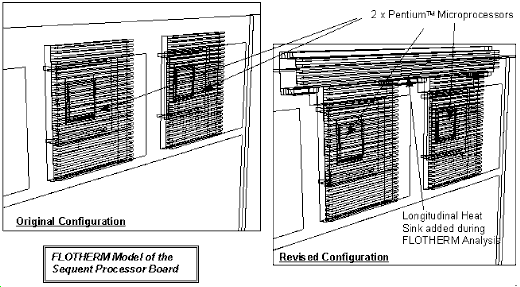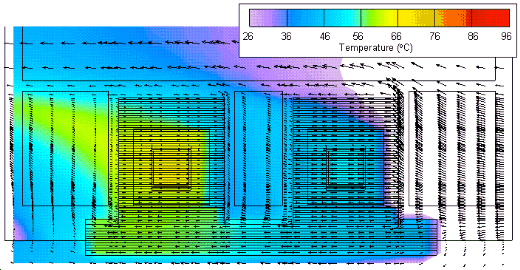解决奔腾微处理器序列中的热设计问题
日期:2012-06-19
Solving Thermal Design Problems in the Pentium Microprocessor Series |
|
Sequent Computer Systems Inc. is a manufacturer of fault-tolerant computer equipment where reliability is paramount. Hank Bosak, Project Engineer at Sequent who designed the cooling system shown here, says: "Packaging microprocessors exceeding 16 Watts into an air-cooled platform which was never intended to cool such high power devices outstripped intuition as well as any other thermal modeling tools previously employed at Sequent. With no boards or components to perform testing on, the FLOTHERM models had to be employed to keep the processor board development on schedule and also to verify if, in fact, the devices could be cooled to appropriate levels … FLOTHERM provided good correlation with experimental data (within 12%), and has proved to be a useful and powerful tool which will be used of future design applications at Sequent."
The new Pentium processors from Intel dissipate up to 16W of heat each - almost twice as much as any of their predecessors. Many companies have developed whole product lines around Intel's microprocessors, and are now tackling the problem of packaging the new Pentium devices into existing configurations designed around the previous generation of devices.
Intel Corporation has supported Flomerics in the development of the first validated thermal model for the Pentium processor. The model is based on Flomerics' software, FLOTHERM, which uses Computational Fluid Dynamics (CFD) techniques to predict the thermal behavior of the chip in it's actual design environment including the effects of heat spreaders, heat sinks, neighboring components and circuit boards. This new thermal model is precisely what designers need to determine the cooling requirements for the new system at the earliest possible stage. Dr. Ram Viswanath, Senior Engineer at Intel in Phoenix, AZ, states: "The FLOTHERM models of the Pentium series microprocessors, being based on a full 3-dimensional solution of the equations which govern the flow of air around the component as well as the conduction within it, represent a significant step forward in enabling designers to assess the thermal requirements for new systems based on the Pentium." Mostafa Aghazadeh, Engineering Supervisor at Intel, says: "The indications are that this represents a major breakthrough in terms of the tools available to system designers for solving practical thermal problems. We believe that this is the way forward for electronics packaging design."
Illustrations courtesy of Sequent Computer Systems Inc. |












 沪公网安备 31010602003953号
沪公网安备 31010602003953号